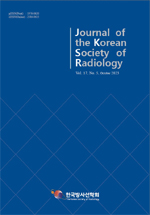
PET/CT에서 최적의 플러싱횟수를 위한 잔류방사능과의 상관분석
Optimization of Flushing through Correlation Analysis between the Number of Flushing and ResidualActivity in PET/CT
- 한국방사선학회
- 한국방사선학회 논문지
- 제17권 제5호
- 2023.10
- 701 - 707 (7 pages)
PET/CT에서 18F-FDG의 주사용량은 SUV(Standard Uptake Value)에 직접적인 영향을 끼쳐 판독결과에 영향을 미칠 수 있다. 따라서 정확한 18F-FDG의 dose 값을 주사하는 것이 중요하다. 본 연구에서는 18F-FDG 주사 시 플러싱 횟수에 따른 주사기와 혈관삽입기구의 잔류방사능간의 상관관계분석을 실시하였다. 실험장비는 CRC-25R 검량계, 3WAY line과 needle, 3 cc 주사기 및 50 cc 생리식염수를 사용하였고 결과값을 SPSS 21 Statics로 통계 분석하였다. 그 결과, 주사기와 혈관삽입기구의 총 잔류 방사능은 2회 플러싱 시 5.84 % 로 가장 높았고 5회 플러싱 시 1.49 % 로 가장 낮게 잔류하였다. 상관관계분석결과, 플러싱 횟수는 주사기의 잔류방사능과 -0.436, 혈관삽입기구와 - 0.300으로 음(-)의 상관관계를 보였다. 플러싱횟수에 따른 주사기, 혈관확보기구의 잔류 방사능 평균값을 일원배치 분산분석(One way - ANOVA)를 실시한 결과, 주사기의 잔류방사능은 4회부터 유의미한 감소를 보였고, 혈관확보기구의 잔류방사능은 5회부터 유의미한 감소를 보였다. 그러나 혈관확보기구의 평균 잔류방사능이 총 잔류방사능의 0.8 %라는 점을 고려할 때, 4회의 플러싱횟수가 가장 합리적으로 보인다.
In PET/CT, the injection volume of 18F-FDG directly affects the SUV(standard uptake value), which can affect the reading results. Therefore, it is important to inject the correct dose value of 18F-FDG. In this study, we performed the correlation between the residual radioactivity remaining in the syringe and catheter insertion device according to the number of flushing during 18F-FDG injection. CRC-25R dose calibrator, catheter insertion devices, 3 cc syringes and 50 cc physiological saline were used in this study, and the results were statistically analyzed. As a result, the total residual radioactivity of the syringe and catheter insertion device remained the highest at 5.84% after two flushing, and the least remained at 1.49% after five flushing. The correlation analysis results showed that the number of flushing had a negative correlation with the residual radioactivity of the syringe at -0.436 and the catheter insertion device at -0.300. As a result of one-way distributed analysis of the average according to the number of flushing, the syringe showed a significant decrease at 4 times, and the catheter insertion device showed a significant decrease at 5 times. However, considering that an average of 0.8% remains in the case of catheter insertion devices, four time flushing seems to be the most appropriate.
Ⅰ. INTRODUCTION
Ⅱ. MATERIAL AND METHODS
Ⅲ. RESULT
Ⅳ. DISCUSSION
Ⅴ. CONCLUSION
Acknowledgement
Reference